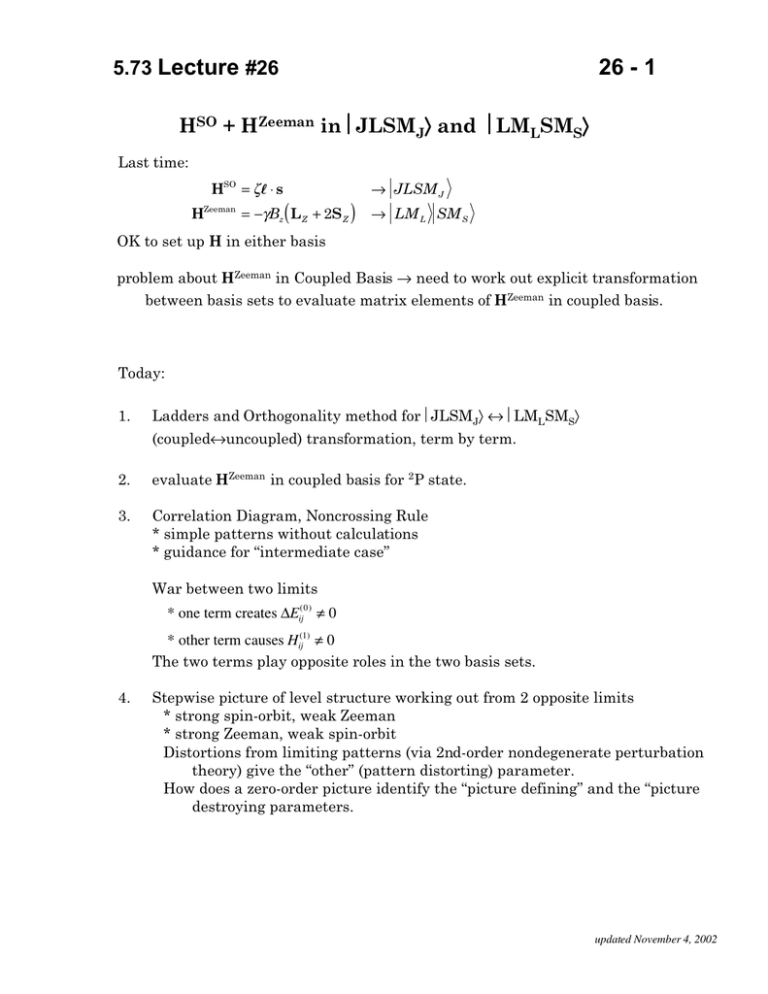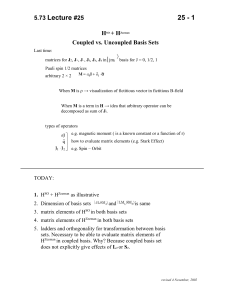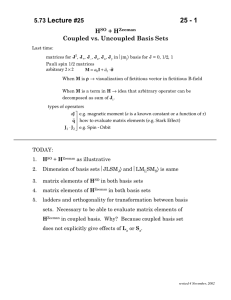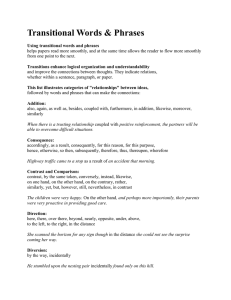( ) Lecture 26 - 1
advertisement

5.73 Lecture #26 26 - 1 LMLSMS⟩ HSO + HZeeman in JLSM J⟩ and Last time: HSO = ζl ⋅ s ( HZeeman = −γBz LZ + 2S Z ) → JLSM J → LM L SM S OK to set up H in either basis problem about HZeeman in Coupled Basis → need to work out explicit transformation between basis sets to evaluate matrix elements of HZeeman in coupled basis. Today: 1. Ladders and Orthogonality method for JLSMJ⟩ ↔ LMLSMS⟩ (coupled↔uncoupled) transformation, term by term. 2. evaluate HZeeman in coupled basis for 2P state. 3. Correlation Diagram, Noncrossing Rule * simple patterns without calculations * guidance for “intermediate case” War between two limits * one term creates ∆Eij( 0 ) ≠ 0 * other term causes Hij(1) ≠ 0 The two terms play opposite roles in the two basis sets. 4. Stepwise picture of level structure working out from 2 opposite limits * strong spin-orbit, weak Zeeman * strong Zeeman, weak spin-orbit Distortions from limiting patterns (via 2nd-order nondegenerate perturbation theory) give the “other” (pattern distorting) parameter. How does a zero-order picture identify the “picture defining” and the “picture destroying parameters. updated November 4, 2002 5.73 Lecture #26 26 - 2 ( ) ( HZeeman = −γBz Lz + 2S z = −γBz J z + S z ) OK Not OK for coupled basis to evaluate matrix elements of Lz or S z in JLSM J need to work out JLSM J = ∑ a m LM L SM S = M J − M L L ML ladders and orthogonality J ± = L± + S± begin with " extreme" J = L + S M J = J ; M L = L, M S = S basis states where there is a 1:1 correspondence JLSM J = J = LM L = L SM S = S =L+S ( ) J − L + S L S L + S = L− + S − LL SS [( L + S)( L + S + 1) − ( L + S)( L + S − 1)]1/ 2 L + S L S L + S − 1 = [ L( L + 1) − L( L − 1)]1/ 2 LL − 1 SS + [S( S + 1) − S( S − 1)]1/ 2 LL SS − 1 L + S L S L + S −1 = [2L ]1/2 LL − 1 c LL SS − 1 1 /2 for 2P L = 1, S = 1/2 3 2 1 12 12 1 /2 [2(L + S )] L L + S L S L + S −1 = L + S 2 = 3 SS + [2S ] 1/2 1 /2 S LL − 1 SS + L + S 1 1 1 0 2 2 u 1 + 3 1/2 11 1 1 − 2 2 1 /2 LL SS − 1 u orthogonality: there are only 2 MJ = 1/2 possibilities, J = 3/2 and J = 1/2 for specified L,S updated November 4, 2002 5.73 Lecture #26 1 11 1 1 = − 3 2 22 1/ 2 26 - 3 11 2 10 + 3 22 1/ 2 11 1 2 − 1 2 (I always choose – sign in front of smaller coefficient - arbitrary phase choice) Nonlecture: Summary for 2 P (coupled → uncoupled) 11 3 13 1 = 11 2 22 22 3 11 2 1 = 3 2 22 1/2 1 11 1 1 =− 3 2 22 11 1 10 + 3 22 1/2 1/2 11 2 10 + 3 22 (2 /3)1/2 1 1 11 − = 1/2 2 2 (1 /3) u 1/2 −(1 /3)1/2 1 1 11 − = 1/2 2 2 (2 /3) u continue down to MJ = –1/2, MJ = –3/2 (or start at MJ = –3/2 and ladder up. Now work in Coupled Representation for HSO + HZeeman ζ HSO + HZeeman = n l ⋅ s − γBzJ z − γBzS z l h diagonal, easy 2 h s J (J + 1) − L( L + 1) − S(S + 1) l ⋅ = recall 2 J z = hM J [ ] off diagonal in J (can’t be off diagonal in L,S,MJ - WHY?) For 2P, there are 2 2 × 2 MJ = 1/2 and MJ = –1/2 blocks. J Evaluate L S MJ 3 /2 1 1 /2 1 /2 S z 3 /2 1 1 /2 1 /2 by inserting the above transformation into the uncoupled basis set. L ML S MS 2 1 1 0 1 / 2 1 / 2 S z 1 0 1 / 2 1 / 2 + 1 1 1 / 2 −1 / 2 S z 1 1 1 / 2 −1 / 2 = 3 3 1 2 1 1 1 h 3 2 + 3 − 2 = h 6 THERE ARE NO OFF-DIAGONAL MATRIX ELEMENTS OF HZeeman IN THE UNCOUPLED BASIS SET. updated November 4, 2002 5.73 Lecture #26 2 3 / 2 1 1 / 2 1 / 2 Sz 1 / 2 1 1 / 2 1 / 2 = − 3 Sz =h 1 /2 1 2 + 2 3 1 /2 26 - 4 1 2 − = − 2 3 etc. for Sz (2P) Basis State 1 / 2 1/ 2 1 / 6 −2 / 3 sym −1 / 6 1/ 2 −1 / 6 +2 / 3 sym 1/6 −1 / 2 3/2 1 1 /2 1/2 3 /2 3/2 1 1/2 1 1/2 1/2 1/2 1/2 3 / 2 1 1 / 2 −1 / 2 1 / 2 1 1 / 2 −1 / 2 3 / 2 1 1 / 2 −3 / 2 (trace Sz = 0) 2 2 × 2’s and 2 1 × 1’s If we had worked in uncoupled representation, HZeeman would have been fully diagonal but HSO Zeeman produces ∆E(ij0 ) ≠ 0 across which HSO has H(ij1) ≠ 0. would be 2 2 × 2's and 2 1 × 1's. H If we work in coupled representation, HSO is diagonal but H Zeeman is off - diagonal. SO Zeeman (0) has Hij(1) ≠ 0. H produces ∆Eij ≠ 0 across which H WAR: HSO tries to force system to coupled representation HZeeman tries to force system to uncoupled representation 2 Limiting Cases: weak and strong spin-orbit. updated November 4, 2002 5.73 Lecture #26 26 - 5 extreme level patterns Bz → 0,ζ n >> 0 l COUPLED (connect same — MJ states) Bz >> 0,ζ n → 0 l UNCOUPLED (M 2 1 / 2ζ np P3 / 2 ) (–1, –1/2) Bzγ (0, –1/2) 0 P1/ 2 ,MS 2Bzγ 0 2 L −ζ np (1, –1/2), (–1, 1/2) − Bzγ (0, 1/2) −2Bzγ (1, 1/2) correlation diagram: noncrossing rule for MJ: why? states of same MJ do not cross In coupled (strong spin - orbit) picture HZeeman is H(1) In uncoupled picture (strong field) HSO is H(1) 2 P matrices for HSO + HZeeman coupled MJ = 3 / 2 MJ = 1 / 2 uncoupled ζ / 2 − 2γBz 2 j = 3 / 2 ζ / 2 − γBz 3 sym j = 1 / 2 2 γBz 3 1 −ζ − γBz 3 ζ 2 − 2γBz 1 /2 ML,MS = (1,−1 / 2) −ζ 2 2 ζ (0,1 / 2) sym − γB −1/2 z CONTINUED AT BOTTOM OF PAGE 26-6 updated November 4, 2002 5.73 Lecture #26 26 - 6 Spin orbit only Βz♦ 0 (J, MJ) MJ Zeeman only (ML, MS) 2Bγ (–1, –1/2) –3/2 Bγ –1/2 (3/2, –3/2) (0, –1/2) ζ/2 (3/2, –1/2) (3/2, +1/2) (3/2, +3/2) 0 1/2 0• +3/2 (1, –1/2) (–1, 1/2) –1/2 –Bγ –ζ (1/2, –1/2) (1/2, +1/2) (0, 1/2) 1/2 –2Βγ (1, 1/2) There are only repulsions (shown by vertical arrows) between same-MJ pairs. coupled uncoupled 1/ 2 E ± M J =1 / 2 ( γBz )2 − γBzζ ζ γB 9 = − − z ± ζ2 + 4 2 16 4 4 M J = −1 / 2 j = 3 / 2 ζ / 2 + 2γBz 3 sym j = 1 / 2 E ± M J = −1/2 2 1/ 2 γBz 3 1 −ζ + γBz 3 − ζ γB 9 1 = − + z ± ζ 2 + γBz 4 2 16 4 E MJ = −3 / 2 E± = same as coupled (even though matrices are different) ( ) ζ 2 + 2γBz 2 γB ζ − z 4 γB z 2 −1/2 ζ sym − ζ 2 1 /2 E ± = same as coupled ζ 2 + 2γBz updated November 4, 2002 5.73 Lecture #26 26 - 7 Energy eigenvalues come out to be identical (as they must) in both representations. Coupled picture is good for 2nd order perturbation theory in the weak field (|γΒ| << ζnl) limit. Zeeman splitting (and tuning rates, H coupled first order picture correction ( 0) =H E (1) = H Zee SO dE , as B z is varied) dB z second order correction E ( 2) = 2γΒz H Zeeman ij 2 E (i 0 ) − E (j0 ) MJ = –3/2 +2/3 γΒz + 4 27 ( γBz )2 ζ MJ = –1/2 ζ 2 } MJ = 1/2 + 274 ( γBz )2 ζ –2/3 γΒz MJ = 3/2 –2γΒz ∆MJ = 0 matrix elements 1/3 γΒz MJ = –1/2 –ζ } − 274 ( γBz )2 ζ MJ = 1/2 –1/3 γΒz – 274 ( γBz )2 ζ updated November 4, 2002 5.73 Lecture #26 26 - 8 r r Uncoupled picture is good for strong field limit where Bz causes L + S to uncouple r from J and into the laboratory (Paschen - Back limit). ZERO-ORDER FIRST-ORDER SECOND-ORDER (ML, MS) (–1, –1/2) 2γΒz MJ (–3/2) +ζ/2 (–1/2) γΒz 0 (0,–1/2) 2 +ζ /2γΒz (1,–1/2) (–1,1/2) (1/2) +ζ /2γΒz –ζ/2 2 –ζ2/2γΒz (–1/2) –γΒz (0,1/2) –ζ2/2γΒz (1/2) –2γΒz (1,1/2) Regular Zeeman Pattern. (3/2) +ζ/2 Small distortions from equal intervals, from which ζ may be determined. Extra distortions. Repulsions between SameMJ components This is a regular Zeeman pattern, but with small distortions (shown as vertical arrors on expanded scale) from equal intervals, from which ζ may be determined. updated November 4, 2002




